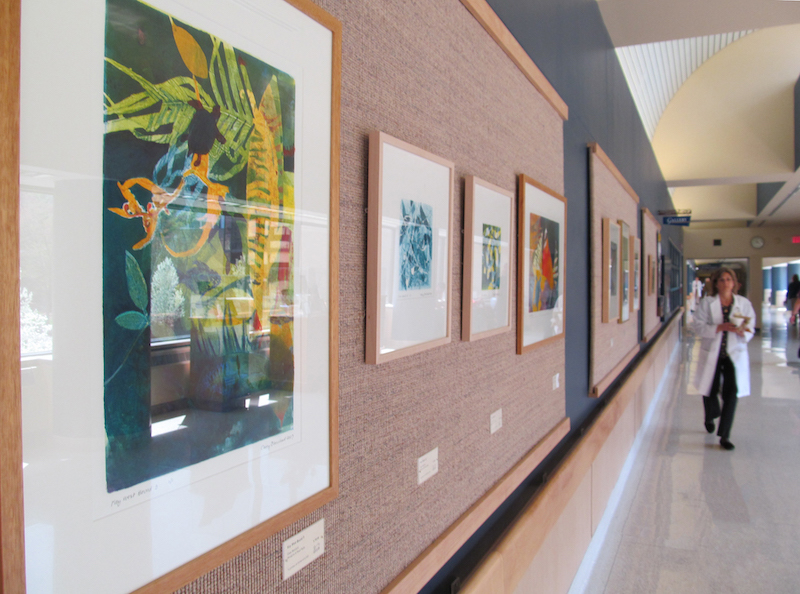If you’ve spent much time in hospitals, you know that no two are the same. Architecture differs, food varies, and good luck trying to find your way around. However, you can always count on one thing to be consistent; the art always looks like a Windows 10 screensaver.
It’s true. Hospital art is notoriously bland, and with reason; research has long endorsed a better healing environment created through art depicting – you guessed it – nature scenes. A quick literature review can link any possible positive patient outcome to the use of such images over other styles of art. A 1993 study showed nature images resulted in lower blood pressure in patients waiting for surgery[1]. A Swedish study found that nature images even decreased the amount of pain medication patients required after heart surgery[2]. Nature images above CT machines? Calmer patients[3]. Nature images in emergency departments? Better behavioral outcomes[4]. We could go on all day, and while it’s dull, it’s also incredibly well documented. Digging through the research, you could find justification for every wall of the hospital to depict an image of a flowing river/open-foreground field/lake sunset.
Or could you? In reviewing the research, a pattern is undeniable; these studies all make their recommendations based on components of a hospitalization that are particularly anxiety inducing such as before a surgery, during imaging, or in the emergency department. It begs the question, does such a body of research dismiss the potential benefits of more diverse art choices in hospital settings by not thinking of more broad applications?
Take abstract art, perhaps the genre furthest from healthcare’s beloved natural scenes. Many of these same studies that praise nature-based art vilify abstraction as causing anxiety and unsettling patients[2]. After all, much of the calming effect from seeing a picture of a nice wind-swept field comes from the fact that it doesn’t take any work on the viewer’s part. It’s just a field. Seeing a picture of it doesn’t require interpretation, emotional analysis, or self-projection. Instead, one just has to recognize it as a field, take comfort from its non-threatening familiarity, and avoid thinking about anything else. Abstract, or otherwise formless, art does not afford us the same opportunity. Viewing it requires work we may not even recognize, forcing viewers to interpret the emotions it arouses in them. Instead of instantly telling you how to feel, it can reflect and amplify the emotions that are already there.
This same idea applies to more than just abstract art. After all, art styles and genres can be described on any number of spectrums, as can the effects they have on the viewer. A piece depicting human figures in a unifying act could help lonely patients feel more connected to others. A piece utilizing warm social colors (as opposed to the more widely research-supported colors and styles) could help facilitate more open conversations in common areas. An abstract piece that challenges a patient on hospital day 50 during a walk through their ward could break up their routine and offer some much needed mental and emotional stimulation.
These scenarios, while very real, are much harder to measure and replicate in art preference research. As such, a quick literature review would continue to advocate for nice, uniform nature scenes meant to calm patients, especially in moments of trauma, anxiety, and emotional distress. While these of course have a place, they certainly don’t account for every moment of the hospital experience. Furthermore, every hospital course is different, and will require different elements at different times. Patients will not only need to be calm; at times they will need to be motivated. Energized. Encouraged. Perhaps even made to feel uncomfortable. Art, as it always has, can play a huge role in these moments when utilized correctly.
An example of how this could look is grouping art pieces according to the types of spaces they would occupy. Nature scenes should continue to be utilized in spaces where their calming effects are needed most like patient rooms, surgical/imaging suites, and emergency departments. Energizing art, in the form of abstractions or depictions of visual movement, should be more present in high traffic hospital hallways, common areas, and physical therapy spaces. Art inducing social interaction, in the form of human figures or geometric unity, should be utilized in long term care units, ICUs, and isolation wards. Challenging art of all genres should be designated in areas for patients that need more stimulation and engagement with their environment. The potential uses vary wildly, just like the needs of the patients who will be viewing them.
It is no secret that artwork transforms the way we interpret the spaces it occupies. On a granular level, that is its fundamental purpose. A well selected piece can help the viewer find new meaning, motivation, purpose, and everything in between. Style can be leveraged, content can be weaponized, and perspective can be hand-delivered when strategically implemented. In this sense, it’s impossible not to see every choice to display artwork as anything other than an opportunity, everywhere in the world but especially in hospitals. Further research, common sense, and a more rounded understanding of the human experience should allow for more aggressive art choices in healthcare settings.
And if nothing else, maybe it won’t be so boring.
References
Brady Anderson is a medical student at the University of Arizona College of Medicine-Phoenix, class of 2025. He loves writing and enjoys the outlet it offers, both intellectually and emotionally. When not studying or trying put his kids to bed, he enjoys chipping away at one of the several books he's reading, exploring Arizona's deserts, and overanalyzing art and culture. He graduated from Brigham Young University in 2020 with a BS in Psychology. Feel free to reach him at bradyanderson@arizona.edu.


